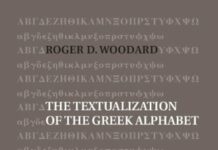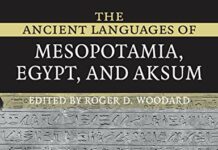
Ebook Info
- Published: 2008
- Number of pages: 286 pages
- Format: PDF
- File Size: 2.23 MB
- Authors: Roger D. Woodard
Description
This book, derived from the acclaimed Cambridge Encyclopedia of the World’s Ancient Languages, describes the ancient languages of Europe, for the convenience of students and specialists working in that area. Each chapter of the work focuses on an individual language or, in some instances, a set of closely related varieties of a language. Providing a full descriptive presentation, each of these chapters examines the writing system(s), phonology, morphology, syntax and lexicon of that language, and places the language within its proper linguistic and historical context. The volume brings together an international array of scholars, each a leading specialist in ancient language study. While designed primarily for scholars and students of linguistics, this work will prove invaluable to all whose studies take them into the realm of ancient language.
User’s Reviews
Editorial Reviews: Book Description A convenient, portable paperback derived from the acclaimed Cambridge Encyclopedia of the World’s Ancient Languages. About the Author Roger D. Woodard is the Andrew Van Vranken Raymond Professor of the Classics at the State University of New York, Buffalo. His numerous publications include The Cambridge Encyclopedia of the World’s Ancient Languages (2004).
Reviews from Amazon users which were colected at the time this book was published on the website:
⭐A very nice jumpstart on old languages of Europe. Nice to see how many of them have common roots and how some words are still preserved in some of the local dialects.
⭐This is volume three of the Cambridge Encyclopedia of the World’s Ancient Languages, a collection of 45 entries covering in principle all languages of which sufficient recorded material is available from before 476 AD to write a meaningful entry about. All entries are of superb quality, so I’ll restrict myself to specific comments on the entries in this volume.The introduction divides the languages into three classes of accessibility: 1. the language’s existence is known, but little else is; 2. there is a reasonable guess at the language’s affiliation; 3. enough is known to sketch a grammar. The first two classes are covered in the introduction, leading to a bewildering variety of scripts and languages; a map is sorely missing. The further chapters cover class 3: Attic Greek, Greek dialects, Latin, Sabellian languages, Venetic, Etruscan, Celtic, Gothic, and Nordic.Attic Greek is shown in considerable detail, with, for example, 10 pages of verb morphology, deriving many forms from PIE. Remarkably, and probably superfluously, all Greek texts are also transcribed in Latin letters. The a dozen Greek dialects is sketched, and located on a map.The authors place Latin, the Sabellian languages, and Venetic in three different chapters, since there are fundamental differences between the three groups, but they fail to tell what these are and on what the split is based. This is confusing, because the languages as presented seem to differ no more than German, Dutch, and Frisian. (The EB explains that one reason is that the three branches form the perfect tense in fundamentally different ways, which points to an ancient split; and that the similarities arose from almost a millennium of contact.) In spite of purported ancient differences Venetic cannot have been too different from Latin: all 10 Venetic words with known PIE etymologies have very similar Latin forms. There are three Sabellian languages known to us: Umbrian, South Picene, and Oscan; almost nothing is known about South Picene, so the entry is about the other two.The Latin entry shows conclusively that Latin is simpler than Greek: the Latin verb forms take only5 pages to explain.As with the Sumerian entry in volume four, the entry on Etruscan in this volume is by itself worth the money: all recent information about Etruscan from the expert in 24 pages. The translation (from German, I think) is described as “masterful” in the preface, but contains a few strange sentences; I’d like to see the original.The Continental Celtic chapter covers Hispano-Celtic, with its own interesting alphabet; Lepontic, written in a modified Etruscan alphabet; and Gaulish, both in Greek and Latin letters. Unfortunately on pages 180 and 181 the translations are missing, which leaves the reader seriously guessing.Gothic: at last a language again about which enough is known for a coherent description without question marks or guesswork. And the author makes full use of it: all the robust Germanic sounds laws are explained and then used to derive large numbers of Gothic forms straight from PIE, through Proto-Germanic and East-Germanic. Very illuminating! In spite of its importance in Gothic, vowel length is not indicated.Ancient Nordic: between 40 and 50 inscriptions, in futhark, which are squeezed for information.The last chapter is about Proto-Indo-European. I hesitate to call it a language; it seems more a container of the reduction of our knowledge of the IE languages. The chapter is quite high-level, meaning: many paragraphs with rules, with hardly an example; grades (full, e-, zero, and lengthened) are listed, but no hint of their application and their relation to pitch is given (some explanation can be found in the chapter on Greek). A short summary of the features covered: five moods to the verb, indicative, subjunctive, optative, injunctive, and imperative; paradigms for indicative (active, middle, and perfect; there is no passive) and imperative; the thematic (= with connecting vowel) and athematic paradigms; and the original secondary endings and derived primary ones. Unfortunately the pitch positions on the endings are not given, so the application of the grades in the two examples comes as a surprise.The index of this volume leaves much to be desired: 1. it is structured on main languages; as a result one has to know that, for example, Phocian is a Greek dialect before one can find it in the index; 2. it is far from complete: for example, North Picene (one paragraph in the Introduction) is not in it, neither under North nor under Picene.In spite of my criticisms this book, like the other four, is going to get prime estate in my book case!
⭐Solid and reliable, but dry even by the standard of such books
Keywords
Free Download The Ancient Languages of Europe in PDF format
The Ancient Languages of Europe PDF Free Download
Download The Ancient Languages of Europe 2008 PDF Free
The Ancient Languages of Europe 2008 PDF Free Download
Download The Ancient Languages of Europe PDF
Free Download Ebook The Ancient Languages of Europe





